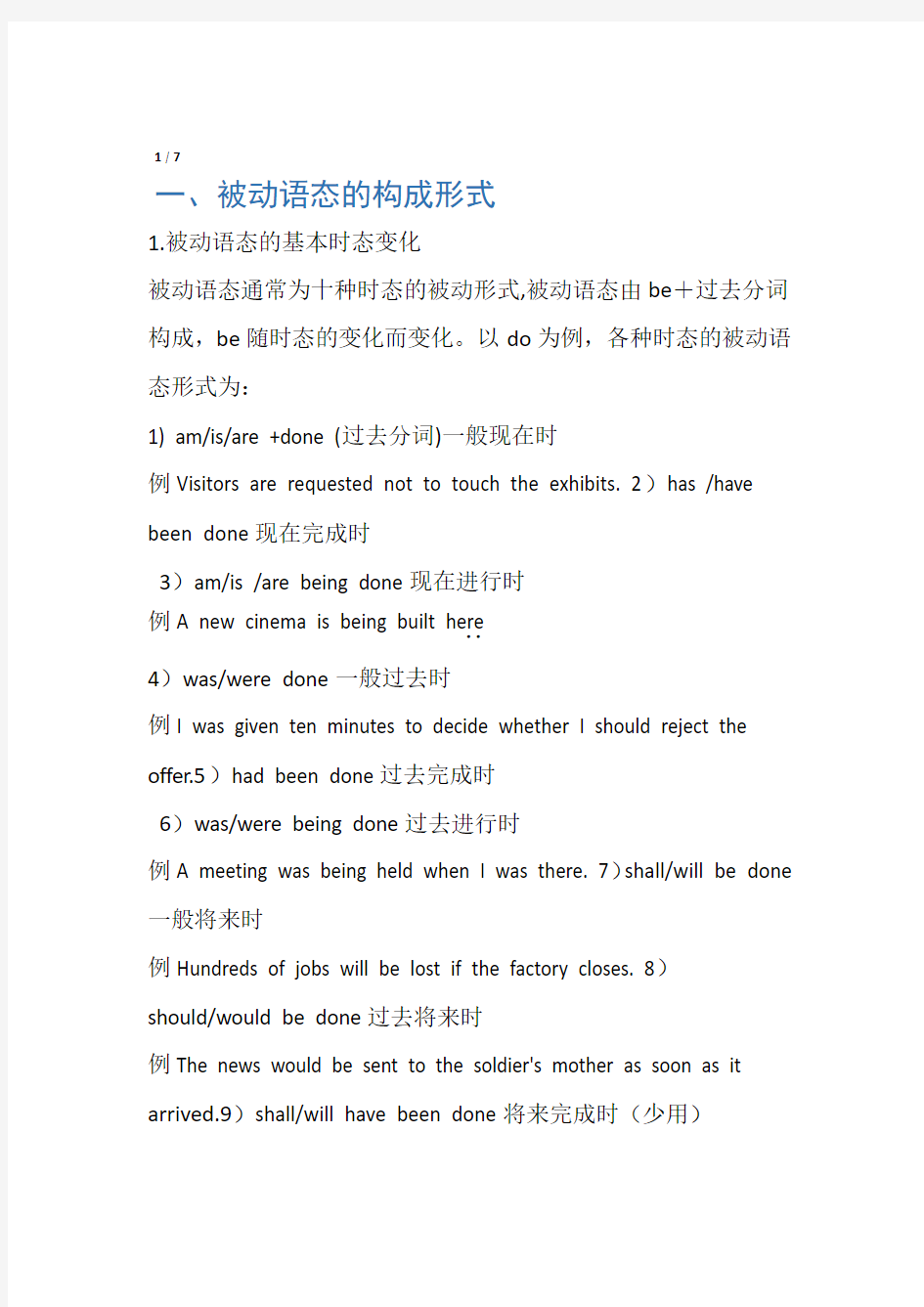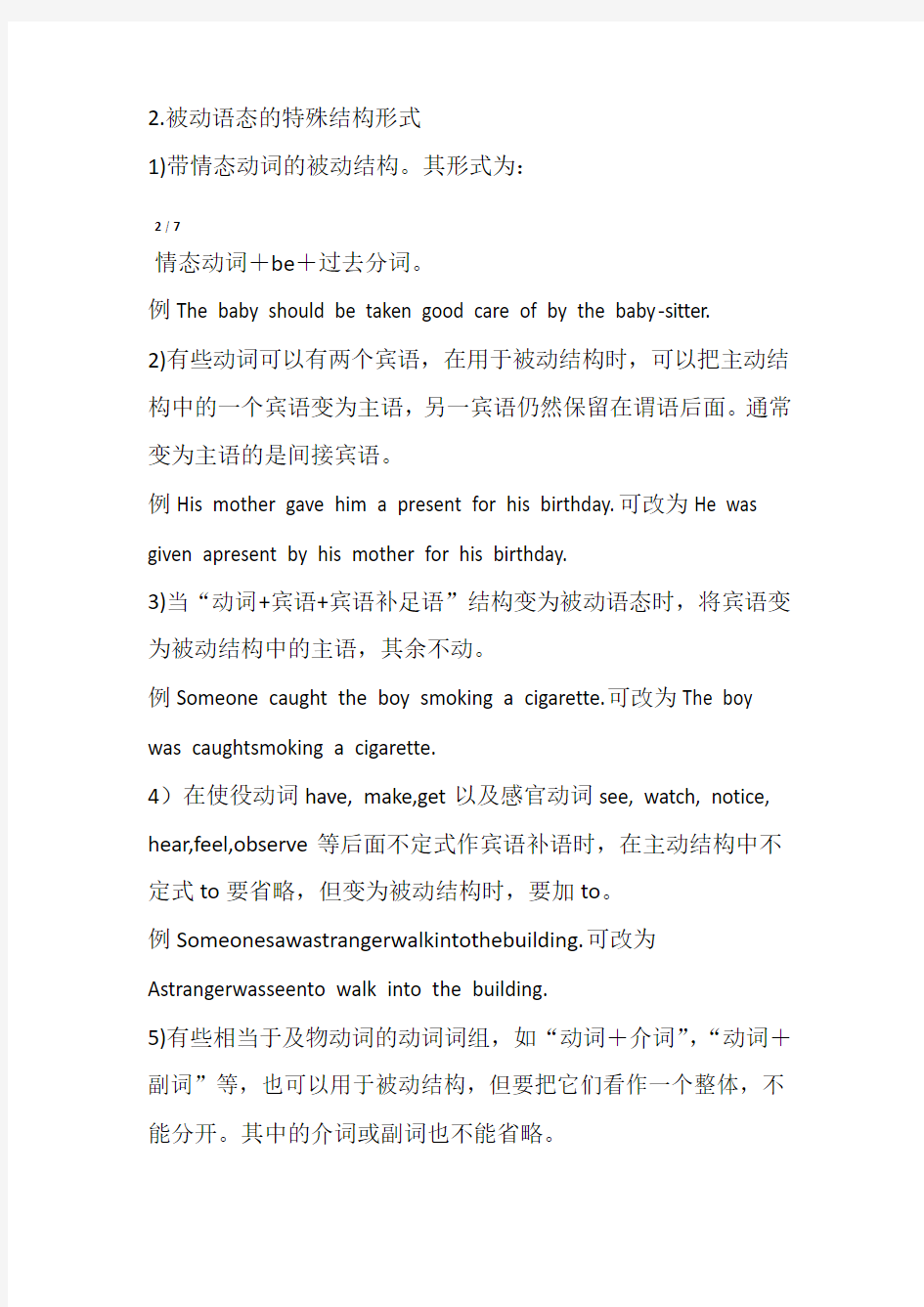初中英语被动语态讲解


1 / 7
一、被动语态的构成形式
1.被动语态的基本时态变化
被动语态通常为十种时态的被动形式,被动语态由be+过去分词构成,be随时态的变化而变化。以do为例,各种时态的被动语态形式为:
1) am/is/are +done (过去分词)一般现在时
例Visitors are requested not to touch the exhibits. 2)has /have been done现在完成时
3)am/is /are being done现在进行时
例A new cinema is being built here..
4)was/were done一般过去时
例I was given ten minutes to decide whether I should reject the offer.5)had been done过去完成时
6)was/were being done过去进行时
例A meeting was being held when I was there. 7)shall/will be done 一般将来时
例Hundreds of jobs will be lost if the factory closes. 8)
should/would be done过去将来时
例The news would be sent to the soldier's mother as soon as it arrived.9)shall/will have been done将来完成时(少用)
2.被动语态的特殊结构形式
1)带情态动词的被动结构。其形式为:
2 / 7
情态动词+be+过去分词。
例The baby should be taken good care of by the baby-sitter.
2)有些动词可以有两个宾语,在用于被动结构时,可以把主动结构中的一个宾语变为主语,另一宾语仍然保留在谓语后面。通常变为主语的是间接宾语。
例His mother gave him a present for his birthday.可改为He was given apresent by his mother for his birthday.
3)当“动词+宾语+宾语补足语”结构变为被动语态时,将宾语变为被动结构中的主语,其余不动。
例Someone caught the boy smoking a cigarette.可改为The boy was caughtsmoking a cigarette.
4)在使役动词have, make,get以及感官动词see, watch, notice, hear,feel,observe等后面不定式作宾语补语时,在主动结构中不定式to要省略,但变为被动结构时,要加to。
例Someonesawastrangerwalkintothebuilding.可改为Astrangerwasseento walk into the building.
5)有些相当于及物动词的动词词组,如“动词+介词”,“动词+副词”等,也可以用于被动结构,但要把它们看作一个整体,不能分开。其中的介词或副词也不能省略。
例The meeting is to be put off till Friday. 3.非谓语动词的被动语态v.+ing形式及不定式to do也有被动语态(一般时态和完成时态)。例I don't like being laughed at in the public.
二、如何使用被动语态
3 / 7
学习被动语态时,不仅要知道被动语态的各种语法结构,还要知道在哪些情况中使用被动语态。
1.讲话者不知道动作的执行者或不必说出动作的执行者(这时可省by短语)。
例My bike was stolen last night. 2.借助被动的动作突出动作的执行者。
例I was given ten minutes to decide whether I should accept the offer. 3.为了更好地安排句子。
例The well-known person got on the bus and was immediately recognized bypeople.(一个主语就够了)
三、It is said that+从句及其他类似句型
一些表示“据说”或“相信”的动词如
believe,consider,expect,report,say,suppose, think等可以用于句型“It+be+过去分词+that从句”或“主语+be+过去分词+to do sth.”。有:
Itissaidthat? 据说,Itisreported that?据报道,It isbelievedthat?大家相信,It is hoped that?大家希望,It is well known that?众所周知,
It isthought that?大家认为,It is suggested that?据建议。
例Itissaidthattheboyhaspassedthenationalexam.(=Theboyissaidto have passed the national exam.)
四、谓语动词的主动形式表示被动意义
1.英语中有很多动词如break,catch,clean,drive,lock,open,sell,read,write,wash等,当它们被用作不及物动词来描述主语特征时,常用其主动形式表达被动意义,主语通常是物。
例This kind of cloth washes well.
4 / 7
注意:
主动语态表被动强调的是主语的特征,而被动语态则强调外界作用造成的影响。
试比较:
The door won't lock.(指门本身有毛病)
Thedoorwon'tbelocked.(指不会有人来锁门,指“门没有锁”是人的原因)
2.表示“发生、进行”的不及物动词和短语,如:
3.系动词没有被动形式,但有些表示感受、感官的连系动词feel,sound,taste,book, feel等在主系表结构中常以主动形式表示被动意义。
例Your reason sounds reasonable 五、非谓语动词的主动形式表被动意义
在某些句型中可用动名词和不定式的主动形式表被动意义。1.在need,want,require,bear等词的后面,动名词用主动形式表示被动意义,其含义相当于动词不定式的被动形式。
例The house needs repairing(to be repaired).这房子需要修理。2.形容词worth后面跟动名词的主动形式表示被动含义,但不能跟动词不定式;而worthy后面跟动词不定式的被动形式。
例Thepicture-bookiswellworthreading..
(=Thepicture-bookisveryworthyto be read.)
5 / 7
3.动词不定式在名词后面作定语,不定式和名词之间有动宾关系时,又和句中另一名词或代词构成主谓关系,不定式的主动形式表示被动含义。
例I have a lot of things to do this afternoon..(to do与things是动宾关系,与I是主谓关系。)
试比较:
I'll go to the post office. Do you have a letter to be posted?(此处用不定式的被动语态作定语表明you不是post动作的执行者。)
4.在某些“形容词+不定式”做表语或宾语补足语的结构中,句子的主语或宾语又是动词不定式的逻辑宾语时,这时常用不定式的主动形式表达被动意义。这些形容词有nice,easy,fit,hard,
difficult,important,impossible,pleasant,interesting等。
例Thisproblemisdifficulttoworkout.(可看作toworkout省略了forme). 5.在too? to?结构中,不定式前面可加逻辑主语,所以应用主动形式表示被动意义。
例This book is too expensive (for me) to buy.
6.在therebe?句型中,当动词不定式修饰名词作定语时,不定式用主动式作定语,重点在人,用被动形式作定语,重点在物。
(用tolose可看成forustolose;例Thereisnotimetolose(tobelost).
用to be lost,谁lost time不明确。)
7.在be to do结构中的一些不定式通常应用主动表主动,被动表被动。然而,由于古英语的影响,下列动词rent,blame,let等仍用不定式的主动形式表示被动意义。
例Who is to blame for starting the fire?
六、介词in, on, under等+名词构成介词短语表被动意义
6 / 7
表示方位的介词与含动作意义的名词合用,含被动之义,其意义相当于该名词相应动词的被动形式,名词前一般不用冠词。
1.“under+名词”结构,表示“某事在进行中”。常见的有:undercontrol(受控制),undertreatment(在治疗中),underrepair (在修理中),underdiscussion(在讨论中), under construction (在施工中)。
例The building is under construction( is being constructed).
2.“beyond+名词”结构,“出乎??胜过??、范围、限度”。常见的有:
beyondbelief(令人难以置信),beyondone'sreach(鞭长莫及),beyondone'scontrol(无法控制),beyond our hope.我们的成功始料不及。
例The rumour is beyond belief(=can't be believed).
3.“above+名词”结构,表示“(品质、行为、能力等)超过??、高于??”。
例Hishonestcharacterisaboveallpraise..=Hishonestcharactercannotbe praised enough..
4.“for+名词”结构,表示“适于??、为着??”。如:
forsale(出售),forrent(出租)等。
例That house is for sale. (= That house is to be sold). 5.“in+名词”结构,表示“在??过程中或范围内”常见的有:
in print(在印刷中),in sight(在视野范围内),等。
例The book is not yet in print..(=is not yet printed) 6.“on+名词”结构,表示“在从事?? 中”。常见的有:
onsale(出售),onshow(展出), on trial(受审)。
例Today some treasures are on show in the museum (= are being showed).
7 / 7
7.“outof+名词”结构;表示“超出?? 之外“,常见的有:
